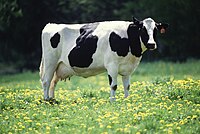
Photo from wikipedia
Abstract Background Even if breed, parity, dietary and environmental management are same, dairy cows still have notable differences in milk yield that may be underpinned by physiologic differences. Objectives This… Click to show full abstract
Abstract Background Even if breed, parity, dietary and environmental management are same, dairy cows still have notable differences in milk yield that may be underpinned by physiologic differences. Objectives This study aimed to investigate the physiological dissimilarities of dairy cows with different milk yields. Methods Thirty cows were sorted into high milk‐yielding cows (group H: 58.93±2.31 kg/day), moderate milk‐yielding cows (group M: 44.99±0.54 kg/day), and low milk‐yielding cows (group L: 24.99±6.83 kg/day) according to milk yield. Blood was collected and serum parameters were assessed. Rumen fluid was collected for the evaluation of rumen fermentation parameters (RFPs) and bacterial community composition (BCC). Results Serum prolactin, growth hormone, glutathione peroxidase, immunoglobulin A and non‐esterified fatty acid had a significantly positive correlation with milk yield (p < 0.05), whereas serum glucagon and total antioxidant capacity had a significantly negative correlation with milk yield (p < 0.05). The concentration of valeric acid and the ratio of acetic acid to propionic acid in the rumen fluid in group H was significantly lower than that in group L (p < 0.05). The concentration of acetic acid and butyric acid in group H was significantly lower than that in groups M and L (p < 0.05). The relative abundances of Ruminococcaceae_NK4A214_group, Prevotella_1, Rikenellaceae_RC9_gut_group, Christensenellaceae_R‐7_group, Muribaculaceae, and Ruminococcus_2 were negatively correlated with milk yield, whereas the relative abundance of Succinivibrionaceae_UCG‐001, Lachnospiraceae_NK3A20_group, Shuttleworthia and Dialister were positively correlated with milk yield (p < 0.05). Conclusions This study indicates that dairy cows with different milk yields have clear divergence in serum indicators, RFPs, BCC and rumen microbial metabolism.
Journal Title: Veterinary Medicine and Science
Year Published: 2022
Link to full text (if available)
Share on Social Media: Sign Up to like & get
recommendations!